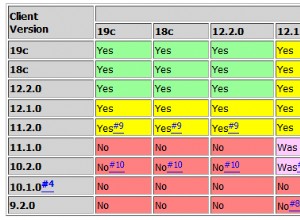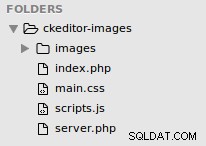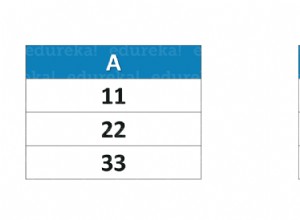No utilice un disparador para esto. La mayoría de las condiciones que ha codificado en los IF anidados (de su disparador) probablemente se pueden realizar a través de restricciones de clave externa y restricciones de verificación. Además, no necesita almacenar la 'X' para WOMAN_ACT en ningún lugar, ya que es un "valor derivado", es decir, puede obtenerlo o generarlo al consultar sus datos. Tal vez el siguiente ejemplo (basado en sus tablas y datos originales) lo ayude a encontrar una solución. Lea los comentarios en el código.
código DDL
create table person (
id number primary key
, registration_number varchar2(9) unique
, primary_number varchar2(9)
-- , women_act varchar2(1) <- not needed!
);
create table consolidated_numbers (
secondary_number varchar2(9) references person( registration_number )
, person_id number references person( id )
);
create table code (
valid_code varchar2(2) primary key
);
-- CHECK constraint added to allow only certain TYPE_IDs
create table history_transaction (
reason varchar2(2) references code( valid_code ) -- valid REASONSs enforced by FK constraint
, person_id number references person( id )
, type_id number check (
type_id in (
120, 140, 1420, 1440, 160, 180, 150, 1520, 1540, 1560 -- only allow these type_ids
)
)
, action_date date
);
Datos de prueba
-- INSERT your initial test data
begin
insert into person (ID,registration_number,primary_number) values(132, '000000001', null);
insert into person (ID,registration_number,primary_number) values (151, '000000002', '000000001');
insert into consolidated_numbers (SECONDARY_NUMBER,person_id) values ('000000002', 132);
insert into code (valid_code) values ('A1');
insert into code (valid_code) values ('T1');
insert into code (valid_code) values ('N2');
insert into history_transaction (reason,person_id,type_id,action_date)
values ('A1', 132, 1420, DATE '2019-01-01');
commit ;
end;
/
La siguiente VISTA seleccionará person_ids de las tablas HISTORY_TRANSACTION, agregará una 'X' a cada una de ellas, y también seleccionará a todas las personas que están "asociadas" con (o:asignadas a) estas identificaciones de CONSOLIDATED_NUMBERS, y también agregará un 'X' a sus identificaciones. (Nota al margen:parece que su tabla PERSON contiene una relación recursiva, por lo que se podría escribir una consulta recursiva. Sin embargo, tendrá una razón para modelar la tabla CONSOLIDATED_NUMBERS, por lo que usaremos un JOIN aquí).
VER
create or replace view personx
as
with PID as (
select distinct person_id
from history_transaction
)
select person_id, 'X' as woman_act -- [Q1] all person_ids from history_transaction
from PID
union
select P.id, 'X' as woman_act -- [Q2] all person_ids associated with ids from Q1
from person P
join consolidated_numbers C
on P.registration_number = C.secondary_number
and C.person_id in (
select person_id from PID
)
;
-- with your initial test data, we get:
select * from personx ;
+---------+---------+
|PERSON_ID|WOMAN_ACT|
+---------+---------+
|132 |X |
|151 |X |
+---------+---------+
Ahora, eliminemos/agreguemos algunos datos y ejecutemos algunas pruebas (ver también:DBfiddle ):
-- test 1
delete from history_transaction ;
select * from personx ;
-- result: no rows selected -> OK
-- test 2
insert into history_transaction (reason,person_id,type_id,action_date)
values ('A1', 132, 1420, DATE '2019-01-01');
select * from personx ;
+---------+---------+
|PERSON_ID|WOMAN_ACT|
+---------+---------+
|132 |X |
|151 |X |
+---------+---------+
-- test 3: add more associations
begin
-- new: person 345 associated with person 132
insert into person (ID,registration_number,primary_number) values (345, '000000345', '000000001');
insert into consolidated_numbers (SECONDARY_NUMBER,person_id) values ('000000345', 132);
commit ;
end ;
/
select * from personx ;
+---------+---------+
|PERSON_ID|WOMAN_ACT|
+---------+---------+
|132 |X |
|151 |X |
|345 |X |
+---------+---------+
Otra prueba antes de entrar en más detalles:
-- test 4
-- add more associations
-- no entry in history_transactions for person(id) 1000
begin
insert into person (ID,registration_number,primary_number) values(1000, '000000777', null);
insert into person (ID,registration_number,primary_number) values (2000, '000000778', '000000777');
insert into consolidated_numbers (SECONDARY_NUMBER,person_id) values ('000000778', 1000);
commit ;
end ;
/
-- output must be the same as before -> result OK
select * from personx ;
+---------+---------+
|PERSON_ID|WOMAN_ACT|
+---------+---------+
|132 |X |
|151 |X |
|345 |X |
+---------+---------+
ÚNETE la vista a la tabla de personas
-- test 5
-- add an entry from person 1000 into the history_transaction table
insert into history_transaction (reason,person_id,type_id,action_date)
values ('N2', 1000, 1420, sysdate);
select * from personx ;
+---------+---------+
|PERSON_ID|WOMAN_ACT|
+---------+---------+
|132 |X |
|151 |X |
|345 |X |
|1000 |X |
|2000 |X |
+---------+---------+
-- test 5: show more details
select P.id, P.registration_number, P.primary_number, PX.woman_act
from personx PX right join person P on PX.person_id = P.id ;
+----+-------------------+--------------+---------+
|ID |REGISTRATION_NUMBER|PRIMARY_NUMBER|WOMAN_ACT|
+----+-------------------+--------------+---------+
|132 |000000001 |NULL |X |
|151 |000000002 |000000001 |X |
|345 |000000345 |000000001 |X |
|1000|000000777 |NULL |X |
|2000|000000778 |000000777 |X |
+----+-------------------+--------------+---------+
La combinación externa es necesaria para PERSON_ID que no tienen filas correspondientes en la tabla HISTORY_TRANSACTION, por ejemplo,
-- test 6
-- add more associations
-- no entry in history_transactions for person(id) 10000!
begin
insert into person (ID,registration_number,primary_number) values(10000, '000007777', null);
insert into person (ID,registration_number,primary_number) values (20000, '000007778', '000007777');
insert into consolidated_numbers (SECONDARY_NUMBER,person_id) values ('000007778', 10000);
commit ;
end ;
/
-- after TEST 6 data have been inserted:
select P.id, P.registration_number, P.primary_number, PX.woman_act
from personx PX right join person P on PX.person_id = P.id ;
+-----+-------------------+--------------+---------+
|ID |REGISTRATION_NUMBER|PRIMARY_NUMBER|WOMAN_ACT|
+-----+-------------------+--------------+---------+
|132 |000000001 |NULL |X |
|151 |000000002 |000000001 |X |
|345 |000000345 |000000001 |X |
|1000 |000000777 |NULL |X |
|2000 |000000778 |000000777 |X |
|20000|000007778 |000007777 |NULL |
|10000|000007777 |NULL |NULL |
+-----+-------------------+--------------+---------+
EDITAR
Si, como se indica en su comentario, debe almacenar un valor en la columna WOMAN_ACT (aunque aparentemente es un "valor derivado"), podría escribir un paquete que contenga procedimientos para todas las operaciones DML requeridas, aún sin usar un activador. Sin embargo, sin conocer la historia completa, es difícil decidir si este sería el mejor camino a seguir. El siguiente ejemplo utiliza un pequeño paquete que contiene procedimientos para establecer valores WOMAN_ACT de la tabla PERSONA y un activador que se activa después de INSERTAR/ACTUALIZAR (tabla:HISTORIAL_TRANSACCIONES). DBfiddle aquí .
tabla PERSONA
create table person (
id number primary key
, registration_number varchar2(9) unique
, primary_number varchar2(9)
, woman_act varchar2(1) check ( woman_act in ( null, 'X' ) )
);
-- all other tables: same as before
PAQUETE
create or replace package pxpkg
is
-- find out whether a certain id (table: PERSON) is a "parent" or a "child"
function isparent( id_ number ) return boolean ;
-- set 'X' values: id_ is a "parent"
procedure setx_parentchildren( id_ number ) ;
-- set 'X' values: id_ is a "child"
procedure setx_childsiblings( id_ number ) ;
end pxpkg ;
/
CUERPO DEL PAQUETE
create or replace package body pxpkg
is
function isparent( id_ number )
return boolean
is
secondarynumbers pls_integer := 0 ;
begin
select count(*) into secondarynumbers
from consolidated_numbers
where person_id = id_ ;
if secondarynumbers = 0 then
return false ;
else
return true ;
end if ;
end isparent ;
--
procedure setx_parentchildren ( id_ number )
is
begin
update person
set woman_act = 'X'
where id in (
select id from person where id = id_ -- parent id
union
select id from person
where primary_number = (
select registration_number from person where id = id_ -- parent id
)
) ;
end setx_parentchildren ;
--
procedure setx_childsiblings ( id_ number )
is
begin
update person
set woman_act = 'X'
where id in (
with PID as (
select id, primary_number from person
where id = id_ -- current id
and primary_number is not null -- child ids only
)
select id from PID
union
select id
from person
where registration_number in ( select primary_number from PID )
or primary_number in ( select primary_number from PID )
) ;
end setx_childsiblings ;
end pxpkg ;
/
DISPARADOR
create or replace trigger pxtrigger
after insert or update on history_transaction
for each row
begin
if pxpkg.isparent( :new.person_id ) then
pxpkg.setx_parentchildren( :new.person_id ) ;
else
pxpkg.setx_childsiblings( :new.person_id ) ;
end if ;
end pxtrigger ;
/
PRUEBA:consulte DBfiddle




